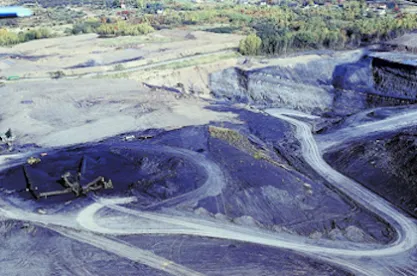The Mine Safety and Health Administration has issued an alert calling attention to hazards associated with handling plastic pipe at Metal/Non-Metal (M/NM) mines.
In a March 3 letter M/NM operators that accompanied the alert, the agency briefly described how six individuals, including two delivery truck drivers and two contract workers, have died in fall-of-material pipe incidents since 2008. The latest fatality occurred in February 2016, when a 61-year-old truck driver was killed at a sand and gravel mine in Texas after being struck by a section of polyurethane pipe weighing close to a ton that had rolled off the side of his truck.
According to the alert, a raised section of large diameter plastic pipe represents a significant suspended load hazard. One reason relates to pipe weight. Twenty-four-inch diameter pipe weighs approximately 1,750 pounds per 50 linear-foot section. Larger diameter pipes weigh more. In addition, because plastic pipes are flexible, suspended sections can wriggle, and bent sections on the ground can move unexpectedly as the pipe tries to straighten itself, the alert stated.
The alert reminded M/NM operators that MSHA standards require that materials not be stacked in a way which creates a fall-of-material hazard, that taglines be attached to loads that may require guidance or steadying while suspended, and that hitches and slings used to hoist materials be suitable for the particular material being handled. The agency recommended that mining personnel assess, identify, and control all job hazards, establish safe work procedures, and task train all members of the crew, with supervisors advised to monitor the jobsite to assure work proceeds safely. The most relevant MSHA standards can be found at 30 CFR §56/57, Subparts H and O.
When unloading pipes, best practices generally include: assessing the stability of the load before unfastening restraints; assuring pipe sections remain properly restrained throughout the unloading process; and keeping ground personnel clear of the truck, its load, and the equipment used to unload the pipes, the alert states. Secondary supports, such as side stakes, may need to be installed before unfastening the load to prevent pipes from falling as they are being unfastened.
Best practices when handling, moving, splicing, and positioning pipe include assuring that slings are in good condition and securely attached, standing clear of suspended pipes, and keeping pipes as straight as feasible to avoid any spring-like motion, according to the alert.
MSHA said it plans to continue walk-and-talk safety and enforcement visits to mine sites in March and has asked mines, miners, and mining industry groups to help spread the word about pipe handling safety to mine operators, supervisors, equipment operators, contractors, and delivery drivers.



 />i
/>i
